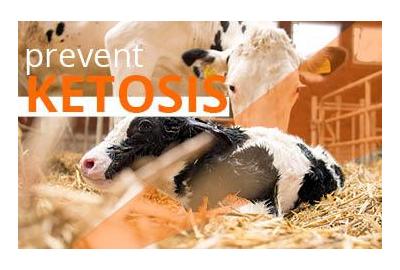

Ketosis in dairy cows
What is ketosis?
Ketosis, also known as lingering milk fever, is a metabolic disease common in dairy cows in the first months after calving. It is caused by a negative energy balance when cows consume more energy for milk production than they take in through their feed.
Causes and hazards
The disease results from cows not consuming enough feed after calving compared to the energy needed for milk production. As a result, the body starts to break down fat reserves, leading to the production of ketones. An excess of ketones results in ketosis.
Ketosis in dairy cattle can have serious consequences. Cows with ketosis lose their appetite and body condition, significantly reducing their milk production. This can lead to economic losses for the farmer. In addition, cows with ketosis may be more susceptible to other health problems, such as uterine infections, mastitis and abomasum displacement, causing further complications and treatment costs. Ultimately, the overall fertility and longevity of cows can be negatively affected.


How to recognise?


Reduced appetite


Reduced milk production


Stiff manure


Acetone breath
Cows with ketosis are often sluggish, have a reduced appetite, take in less concentrate, produce less milk, have stiff manure and lose condition quickly. Their breath may smell like acetone. Ketosis can result from other health problems such as mastitis, uteritis or abomasal displacement.
Treatment and prevention
Ketosis can be quickly diagnosed with a ketone test. Treatment is often with propylene glycol and sometimes glucocorticosteroids for better recovery. Prevention starts as early as the dry-off period by properly managing the condition of cows and feeding them a balanced diet. Immediately after calving, it is important to provide palatable roughage and sufficient concentrate to prevent a negative energy balance.
The use of supplements such as Bolidays Control is therefore appropriate because the rapid intake of calcium significantly reduces the risk of milk fever. The ease of use of this particular bolus is very easy as it can be administered with just one dose.
In addition, it should also be said that timely treatment of other diseases also helps to avoid ketosis.
Cows with ketosis are often sluggish, have a reduced appetite, take in less concentrate, produce less milk, have stiff manure and lose condition quickly. Their breath may smell like acetone. Ketosis can result from other health problems such as mastitis, uteritis or abomasal displacement.
Treatment and prevention
Ketosis can be quickly diagnosed with a ketone test. Treatment is often with propylene glycol and sometimes glucocorticosteroids for better recovery. Prevention starts as early as the dry-off period by properly managing the condition of cows and feeding them a balanced diet. Immediately after calving, it is important to provide palatable roughage and sufficient concentrate to prevent a negative energy balance.
The use of supplements such as Bolidays Control is therefore appropriate because the rapid intake of calcium significantly reduces the risk of milk fever. The ease of use of this particular bolus is very easy as it can be administered with just one dose.
In addition, it should also be said that timely treatment of other diseases also helps to avoid ketosis.

Meer informatie gewenst over onze plannen? Of u wenst een persoonlijk gesprek ter plekke? We staan u graag te woord!
 FR
FR  NL
NL 



